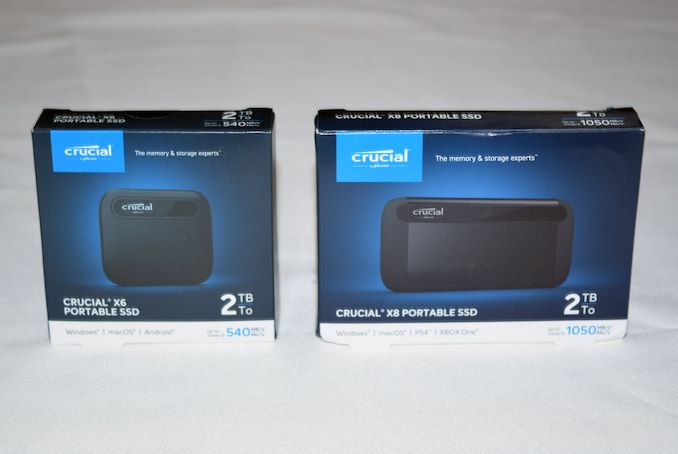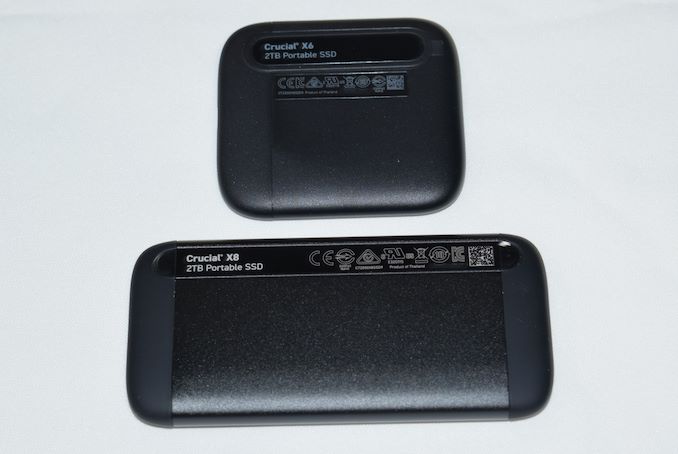Crucial Portable SSD X6 and X8 2TB Review: QLC for Storage On-the-Go
by Ganesh T S on October 21, 2020 8:00 AM EST
Bus-powered portable flash-based storage solutions are one of the growing segments in the consumer-focused direct-attached storage market. The emergence of 3D NAND with TLC and QLC has brought down the cost of such drives. NAND manufacturers like Western Digital, Samsung, and Crucial/Micron who also market portable SSDs have an inherent advantage in terms of vertical integration. Last year, Crucial/Micron had announced its entry into the segment with the QLC-based Crucial Portable SSD X8, which was reviewed in January. A few months back, Crucial updated the lineup with a 2TB model while adding a lower-performance X6 member to the portfolio. This review sets out to determine how these high-capacity portable SSDs fare against the competitors in this market segment.
Introduction
External bus-powered storage devices have grown both in storage capacity as well as speeds over the last decade. Thanks to rapid advancements in flash technology (including the advent of 3D NAND and NVMe) as well as faster host interfaces (such as Thunderbolt 3 and USB 3.x), we now have palm-sized flash-based storage devices capable of delivering 2GBps+ speeds. While those speeds can be achieved with Thunderbolt 3 and USB 3.2 Gen 2x2, mass-market devices have to rely on traditional USB. Entry-level USB drives utilize a flash controller with a direct USB interface, while the mid-range and high-end ones use flash packages behind either a SATA or NVMe SSD controller in conjunction with a SATA/NVMe-USB bridge. In today's review, we take a look at the Crucial Portable SSD X6, a SATA SSD behind a USB 3.2 Gen 2 bridge chip, and the Crucial Portable SSD X8, a NVMe SSD behind a USB 3.2 Gen 2 bridge chip.
From a performance viewpoint, the X6 and X8 fall under different categories that are referred to here on as SATA-class and NVMe-class. Under the SATA-class devices, the Crucial Portable SSD X6 is pitted against the following external SSDs that were reviewed earlier:
- ADATA SC680 960GB
- HP P600 500GB
The Crucial Portable SSD X8 goes head-to-head against the following drives:
- Crucial Portable SSD X8 1TB
- OWC Envoy Pro EX USB-C 2TB
- SanDisk Extreme PRO Portable SSD v2 2TB [JHL6540]
- SanDisk Extreme Portable SSD v2 1TB
- WD My Passport SSD (2020) 1TB
A quick overview of the internal capabilities of the SATA-class drives is given by CrystalDiskInfo.
| SATA-Class External Drives Information |
 |
The X6 supports both UASP and TRIM - the two main things to look out for when dealing with SATA SSDs behind a USB bridge.
On the NVMe-class drives front, CrystalDiskInfo provides the following information.
| NVMe-Class External Drives Information |
 |
Despite TRIM not being explicitly mentioned in the CrystalDiskInfo report, we were able to activate it on the X8. Otherwise, the reported S.M.A.R.T attributes are similar to the ones obtained for the other external SSDs in the same class.
Testbed Setup and Testing Methodology
Evaluation of DAS units on Windows is done with a Hades Canyon NUC configured as outlined below. We use one of the rear USB Type-C ports enabled by the Alpine Ridge controller for both Thunderbolt 3 and USB devices.
| AnandTech DAS Testbed Configuration | |
| Motherboard | Intel NUC8i7HVB |
| CPU | Intel Core i7-8809G Kaby Lake, 4C/8T, 3.1GHz (up to 4.2GHz), 14nm+, 8MB L2 |
| Memory | Crucial Technology Ballistix DDR4-2400 SODIMM 2 x 16GB @ 16-16-16-39 |
| OS Drive | Intel Optane SSD 800p SSDPEK1W120GA (118 GB; M.2 Type 2280 PCIe 3.0 x2 NVMe; Optane) |
| SATA Devices | Intel SSD 545s SSDSCKKW512G8 (512 GB; M.2 Type 2280 SATA III; Intel 64L 3D TLC) |
| Chassis | Hades Canyon NUC |
| PSU | Lite-On 230W External Power Brick |
| OS | Windows 10 Enterprise x64 (v1909) |
| Thanks to Intel for the build components | |
Our evaluation methodology for direct-attached storage devices adopts a judicious mix of synthetic and real-world workloads. While most DAS units targeting a particular market segment advertise similar performance numbers and also meet them for common workloads, the real differentiation is brought out on the technical side by the performance consistency metric and the effectiveness of the thermal solution. Industrial design and value-added features may also be important for certain users. The remaining sections in this review tackle all of these aspects after analyzing the features of the drives in detail.











22 Comments
View All Comments
luxuryhousebuild - Wednesday, June 23, 2021 - link
At that point they will spend more hours requesting and examining many hard offers from exchanges to assemble a careful and exact financial plan. Given this time venture, it is commonplace for truly solid developers to be made up for their pre-development administrations. You can find an assortment of solutions to this inquiry; https://astorhomesbydesign.com.au/services/ interestingly, you feel great with the pay the manufacturer requests and with how they clarify their part in the pre-development measure for your task.Duncan Macdonald - Thursday, October 22, 2020 - link
This is QLC flash - most QLC will not reach beyond 1000 cycles - some will only reach a few hundred - the rated TBW IS important. Also the write speed on QLC often degrades as the cycle count increases.zepi - Thursday, October 22, 2020 - link
I don't care slightest about write endurance - I have hard time envisioning a use case where this kind of drive is written to death. Even few hundred P/E cycles is a lot for a normal person. If you are not a "normal person" and your workload is heavy, then go and buy something else.However, what I'd be very afraid is the data retention. QLC - drive being unplugged for reasonably long periods of time etc.
It is completely normal for people to take backups, transfer bunch of files etc. and expect them to be readable in half a year from writing after storing the drive in the glove compartment of their car or whatever crazy people do.
Is the data readable after such period? No idea.
AMDSuperFan - Thursday, October 22, 2020 - link
Ganesh - looking at the boxes in your picture they look pretty much banged up. Were these new or used drives that you tested here? I think you are an excellent writer.Oxford Guy - Monday, October 26, 2020 - link
"The emergence of 3D NAND with TLC and QLC has brought down the cost of such drives."You meant:
The emergence of 3D NAND with TLC has brought down the cost of such drives. QLC, meanwhile, is about increasing margin for drive makers and decreasing quality for consumers."
Oxford Guy - Monday, October 26, 2020 - link
"I don't care slightest about write endurance - I have hard time envisioning a use case where this kind of drive is written to death. Even few hundred P/E cycles is a lot for a normal person. If you are not a "normal person" and your workload is heavy, then go and buy something else. However, what I'd be very afraid is the data retention. QLC - drive being unplugged for reasonably long periods of time etc."Drive death in the consumer realm has always been mainly about firmware/controller bugs (or, possibly defective NAND), not the NAND wearing out through use. The most extreme examples I can think of are the Sandforce 2 controllers from OCZ that bricked drives when OCZ switched to 64-bit planar MLC (without telling anyone) and Intel's G2 drive that had a data corruption problem due to bad firmware.
(The Sandforce problem was never solved by a plethora of firmware patches. OCZ pretended that it solved the issue by letting people return the drives but the people who spent the most money (on the highest capacity drives, the 240 GB ones) were not allowed to return them! I have three bricked 240 GB OCZ drives. Two of them are drives OCZ sent when the first ones bricked.)
The differences between things like planar MLC and planar TLC have been about other problems. Planar TLC from Samsung didn't result in drive death (the red herring everyone talks about). Instead, it was voltage drift that caused the data to have to be constantly rewritten as a kludge "solution" to very poor performance. That much more frequent writing slows performance, makes one question the safety of storing the drive powered off for long periods, and can lead to the NAND wearing out I suppose.
Drive death from worn-out NAND has been a red herring for the most part, while other serious drawbacks to increasing the number of voltage states (by adding layers) have been whitewashed. Well, it looks like QLC brings back the drive death from worn-out NAND problem back a bit while having all of the drawbacks of there being so many more voltage states (which increases the problem of drift drastically).
The only things going for it is that it's 3D instead of planar and that capacities have increased which helps to mask the issue for most consumer workloads. Regardless, I consider QLC to be an unsatisfactory solution to a problem consumers didn't face: how to increase margin for the companies selling drives beyond what 3D TLC offers. That's the real driving force being QLC. It is not giving consumers a much better capacity deal for their money. The economy of scale factor, instead, works against consumer value by increasing the price of 3D TLC. Companies use that as an excuse to keep prices of QLC too high. Neat trick, for as long as they can make it last. By winding down TLC capacity, they can do it for as long as they like, so long as no one decides to fight the current and keep high volume TLC production going and reasonable pricing for it (in defiance of the scarcity dynamic).
happythanksgives - Tuesday, November 10, 2020 - link
Clearly, your Thanksgiving menu is critical, yet the event is a long ways past essentially stacking our plates. Thanksgiving is an occasion to exhibit your gratefulness for your partners, family, and all that you have for the duration of regular daily existence https://happythanksgiving2020.com/ . These true Thanksgiving proclamations will assist everyone with recollecting the clarification behind the season. This overview is overflowing with clever words that would make for an exceptional event toast or even as a respectable Thanksgiving engraving through online systems administration media.Henry jones - Monday, November 23, 2020 - link
I guess there is no need to compare 35$ product with the expensive onehttps://ynntechnology.com/product/dry-ice-machine/
iOSEmusapps - Monday, March 15, 2021 - link
It is seen as that getting changed applications is very irksome in iOS, yet iOSEmus simplified this dazzling. It has a whole library of the https://iosemus-app.com/ relative multitude of top notch applications that can fulfill you truly particularly perky. Do whatever it takes not to confide in me? I BET you should endeavor this.mp3pawtv - Monday, July 5, 2021 - link
Mp3Paw Download Free Mp3 Music in High Quality – Can I download free MP3 Music from MP3PAW or how might I will download Free films from MP3paws? https://mp3paw.tv/ Here in this article, you would have the option to gain proficiency with a ton about the mp3 paw download and furthermore how to get to the mp3paw download page to download the decisions of your Mp3 music melodies.